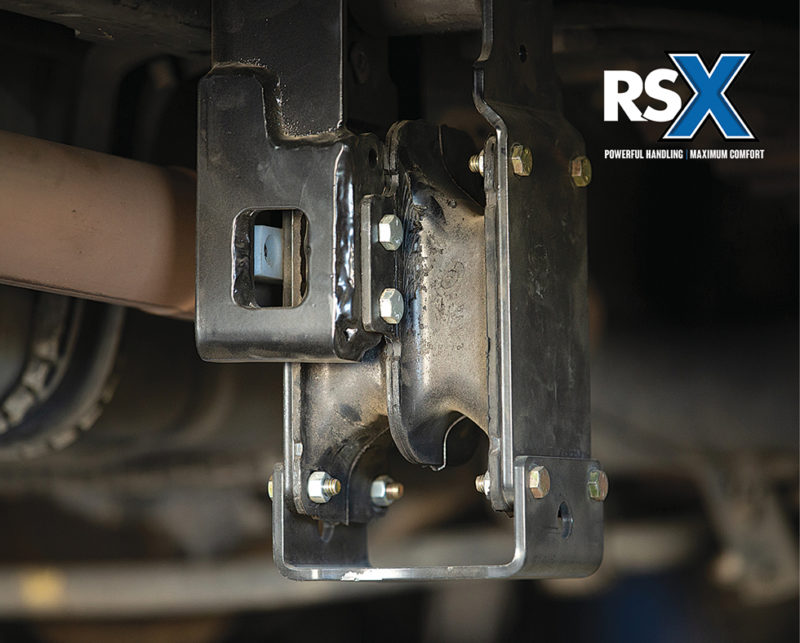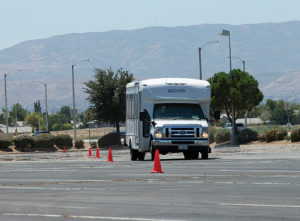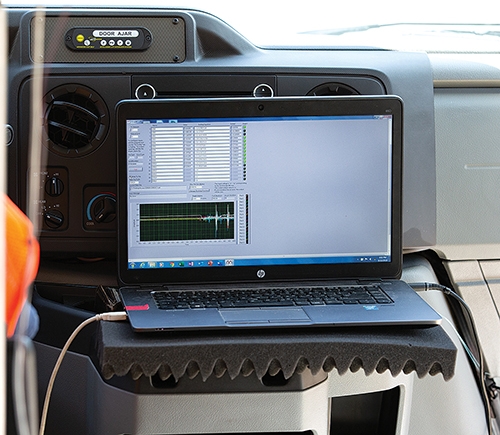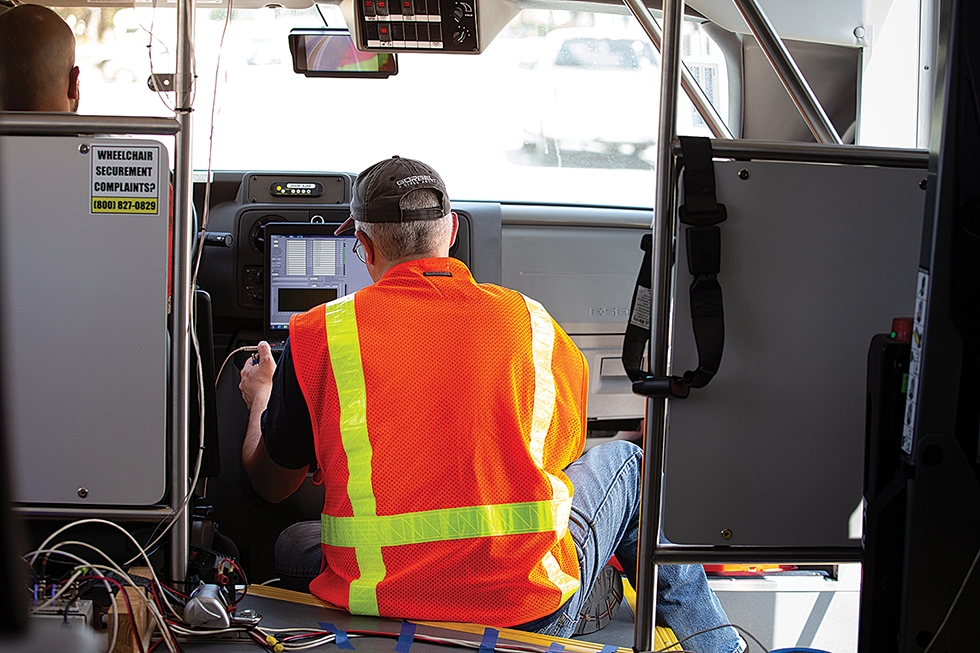
![]()
For the customers of Access Services, the paratransit service for Los Angeles County’s 45 public fixed-route transit operators, ride quality is of paramount importance. To that end, Rick Streiff, Access Services’ Senior Manager of Fleet Design, Maintenance and Safety, said that factory-stock suspension systems are simply not an option for the agency.

“Our fleet is made up of many low-floor minivans, followed by cutaway buses in A, B and C classes, denoting vehicle size,” Streiff said. “I wouldn’t even try to build a cutaway vehicle with a regular suspension in it. The ride is not smooth. Cutaway chassis are basically designed to ride like trucks or other cargo vehicles. When we operate cutaway vehicles, our gross vehicle weight rating (GVWR) is much lighter than that of a truck, so factory-stock suspensions provide extremely rough rides.”
Streiff started working at Access Services in 1996 and found, at that time, that the most common complaint from riders was about rough rides. Since then, he has helped ensure that each Access cutaway bus is equipped with a rubber suspension or other system specialized for paratransit service.
“Transit is about improving quality of life for its riders”
In 1996, at a Society of Automotive Engineers trade show in Detroit, Streiff encountered representatives from MORryde – today a leader in transit bus, aftermarket, towable, motorhome, truck and jeep suspensions. At the time, the company had yet to enter the transit bus market. Joe Carroll, manager of research and development at MORryde, sent some test parts to Los Angeles for Streiff to work with. After running some tests with the parts on a maintenance crew cab, Streiff was impressed with the suspension’s ride and ease-of-maintenance.
Access began spec’ing MORryde suspensions into its new paratransit cutaway vehicles and since 1997, Streiff said, any Access Services vehicle in excess of 10,000 GVWR is now equipped with a MORryde system.
MORryde uses rubber suspension systems in conjunction with standard factory systems to deliver improved ride quality, regardless of a vehicle’s number of occupants. The rubber shear springs are mounted in such a way to allow the standard leaf springs to achieve up to 2 inches of additional suspension travel in a full jounce or rebound. This technology translates to a softer ride for all passengers, and cutaway buses which no longer ride like trucks.
These rubber suspension systems are engineered to provide improved ride quality for each vehicle make and model. The systems can be ordered and installed with a new unit from the bus manufacturer or installed as an aftermarket upgrade on most models already in operation.
“The system has since made a lot of headway in transit, for the same reasons we use it at Access Services,” Streiff said. “It corrects problematic ride issues in a half-load or a no-load situation, at a fraction of the running cost of air-ride or full hydraulic suspensions.”
Cost savings and less maintenance
For Access Services, MORryde’s appeal is threefold: smooth rides; cost; and ease of maintenance.
“The rubber in our suspensions isolates and absorbs shock and vibration, providing results similar to some of the market’s more premium suspension upgrades – but very cost-effectively, and it is much easier to inspect and maintain,” Carroll said.
Using only a flashlight, maintenance techs can visually inspect the MORryde’s rubber components for cracks or tears. The springs can develop wear over time from normal use, Carroll said, but replacement is not necessary unless a substantial tear occurs on the rubber. The rubber springs are serviceable components and can be changed out in around 30 minutes.
“If an air-ride suspension fails, there are a number of components which may contribute to that failure,” Carroll said. “It requires much more troubleshooting before the vehicle is back on the road. Our visual inspection takes minutes, and, with the aid of online instructions, replacement is quick and easy.”
Jack Enfield, sales and marketing manager for MORryde, added that the system’s upfront cost is a fraction of what other systems cost to upgrade, and the capabilities for quick visual inspections creates much lower system lifecycle costs.
“Transit is about improving quality of life for its riders,” he said. “When you have older or medically fragile passengers experiencing rough rides, that problem needs addressing. Agencies often must make the most economical choice. There is really no comparison between MORryde’s low lifecycle costs and the rest of the market.”
Though MORryde frontloads any new deployment with maintenance training, the system’s relatively simple maintenance allows for Access techs to quickly review information online in the event of a failure.
“Anyone familiar with modern medium-class vehicles would not have an issue working with the MORryde system,” Streiff said. “It typically consists of switching out one faulty part, much like changing the shock absorbers on a standard truck – whereas many other premium suspension repairs are much more expensive and involved.”
The RSX
Access Services was a natural choice to trial the latest suspension system from MORryde — the RSX. Carroll said that the RSX system includes the MORryde RS rubber suspension; shock absorbers finely tuned to reduce tire hop in medium-duty buses; and a heavy-duty sway bar to improve cornering and reduce body roll.
MORryde’s base RS system, Carroll explained, offers a 30% to 40% improvement in rideability compared to most standard cutaway suspensions. However, those improvements are most felt in the vehicle’s rearward seats and wheelchair positions. With the RSX package, MORryde not only upgraded the rear hangar and shackle, but also the entire vehicle’s shock absorbers – resulting in improved drivability, handling and driver comfort.
Carroll and Streiff worked together to test the RSX as part of a three-vehicle trial. First, MORryde added accelerometers, string potentiometers and other instruments to a cutaway vehicle equipped with a competitor’s premium upgraded product. Streiff and the team at Access put the vehicle through a controlled trial and provided the data to MORryde.
 Access simultaneously ran an identical test on another vehicle of the same make but equipped with the standardized MORryde Rubber Leaf (RL) suspension. When that test was complete, MORryde swapped out the RL suspension with the new RSX.
Access simultaneously ran an identical test on another vehicle of the same make but equipped with the standardized MORryde Rubber Leaf (RL) suspension. When that test was complete, MORryde swapped out the RL suspension with the new RSX.
Streiff said his team valued the opportunity to ride along on the tests, feeling the difference between the three suspensions as they navigated the testing courses. Afterward, the data gleaned from the tests proved invaluable for both MORryde and Access Services.
“The RSX’s performance was so much better than I predicted,” Streiff said. “The competitor’s upgraded suspension performed really well, especially in slalom. But the RSX was neck-and-neck with it – I am not sure the average driver would be able to tell the difference. It was amazing to see, when factoring in the cost-savings and easy maintenance.”
“The sway bar really helps with the system’s ride and handling,” he added. “After witnessing the tests, we made the decision to use the RSX in any cutaway vehicle lighter than Class C. We are continuing to run the vehicle from the test in Lancaster, California.”
Enfield said that MORryde is most excited about how the RSX improves the system’s ride and handling, particularly relative to driver retention. With agencies constantly experiencing driver turnover and shortages, any solution which cost-effectively enhances the day-to-day life of drivers is welcome.
“We have always served passengers well with the ride quality on our systems,” he said. “But by now improving the ride for drivers, we can give agencies another way to recognize and be sensitive to those employees. It’s a total package.”


